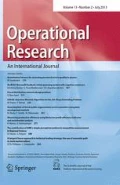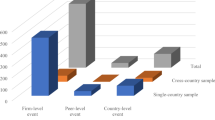Abstract
This study tests the market efficiency hypothesis through the cointegration methodology using forward rates and spot exchange rates of different maturities for the British Pound, the Japanese Yen, and the German Mark exchange market against the USA Dollar. Results indicate that the foreign exchange market is efficient in the long run but we reject the Forward Rate Unbiasedness Hypothesis in the short run, and as a result the spot rate is not an unbiased forecast of the forward rate. These results have significant implications for the government policy makers and these currencies’ foreign exchange markets.
Similar content being viewed by others
References
Baillie, Richard T., and Bollerslev, Tim, (1994), “Cointegration, fractional cointegration, and exchange rate dynamics” Journal of Finance 49, pp. 737–45.
Delcoure, N., Barkoulas, J., Baum, C., and Chakraborty, A., (2003), “The forward rate unbiased hypothesis reexamined: evidence from a new test” Global Finance Journal, 14, pp. 83–93.
Dickey, D. A., and Fuller, W.A., (1981), “Likelihood ratio test for autoregressive time series with a unit root” Econometrica, 49, pp. 1057–72.
Diebold, F.X., Gardeazabal, J., and Yilmaz, K., (1994), “On cointegration and exchange rate dynamics” Journal of Finance, 3, pp. 727–735.
Engle, C., (1998), “Long-run ppp may not hold after all” unpublished manuscript, Department of Economics, University of Washinghton, Seattle, WA.
Engle, R.F., and Granger, C.W.J., (1987), “Cointegration and error correction: representation, estimation and testing” Econometrica, 55, pp. 251–76.
Fama, E. (1970), “Efficient capital markets: a review of the theory and empirical work” Journal of Finance, 25, pp. 383–416.
Fama, E. (1976). Efficient capital markets: reply. Journal of Finance, 3, pp. 143–45.
Hai, W., Mark, N., and Wu, Y., (1997), “Understanding spot and forward exchange rate regressions” Journal of Applied Econometrics, 12, pp. 715–734.
Hakkio, C.S. and Rush, M., (1989), “Market efficiency and cointegration: An application to the sterling and deutschmark exchange markets” Journal of International Money and Finance, 8, pp. 75–88.
Johansen, S., (1988), “Statistical analysis of cointegrating vectors”, Journal of Economic Dynamics and Control, 12, pp. 231–45.
Johansen, S., and Juselius, K., (1990), “Maximum likelihood estimation and inference on cointegration with application to thedemand for money” Oxford Bulletin of Economics and Statistics, 52, pp. 169–210.
Karfakis, C. and Moschos, D., (1994), “Tests for efficiency in the eurodrachma market, Applied Financial Economics, 4, pp. 375–81.
Karlsson, J. and Rohl, D. (2002), “Market efficiency, cointegration and causality” International Macroeconomics Term Paper, Lund University, Department of Economics.
Kaskarelis G. and Siriopoulos, C. (1993), “Foreign exchange market efficiency widening” 6th Panhellenic Statistics Conference Proceedings, H.S.I. Editions, pp. 141–150.
Markellos, Raphael N. and Siriopoulos, C., (1997), “Nonlinear error — correction models in the Greek money market” Zopounidis, Konstantin (ed.), New operational approaches for financial modeling. 19th meeting of the Euro working group, Chania,Crete,Greece, November 28–30, 1996, Heidelberg: Physica-Verlag. Contributions to management science, pp. 173–181.
Napolitano, O. (2000), “The efficiency hypothesis and the role of ‘news’ in the euro/british pound exchange rate market: an empirical analysis using daily data” ISER working papers, Institute for Social and Economic Research.
Phillips, P. C. B., and Perron, P., (1988), “Testing for a unit root in time series regression” Biometrica, 75, pp. 335–46.
Sephton, P. S., and Larsen, H. K., (1991). “Tests of exchange market efficiency: fragile evidence from cointegration tests” Journal of International Money and Finance, Elsevier, 10(4), pp. 561–570.
Tzavalis, E. and Wickens, R.M. (1997) “Explaining the failures of the term spead models of the rational expectations hypothesis of the term structure” Journal of Money, Credit and Banking, 29 (3), pp. 364–80.
Zivot, E. (1998), “Cointegration and forward and spot exchange rate regressions” Econometrics 9812001, the former EconWPA.
Author information
Authors and Affiliations
Rights and permissions
About this article
Cite this article
Kenourgios, D., Samitas, A. & Christodoulou, A. Long run and short run test for market efficiency: Evidence for the British Pound, the German Mark and the Japanese Yen. Oper Res Int J 6, 163–182 (2006). https://doi.org/10.1007/BF02941230
Issue Date:
DOI: https://doi.org/10.1007/BF02941230




